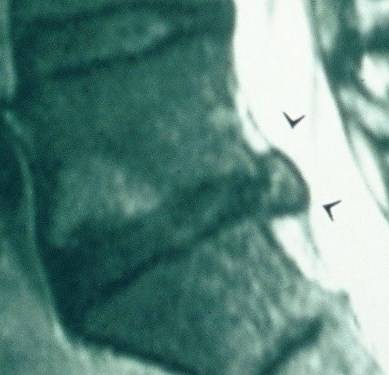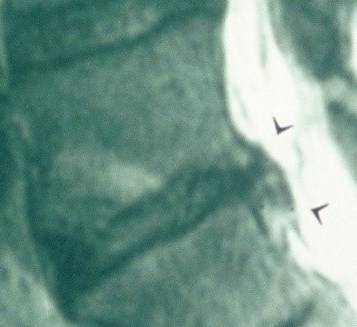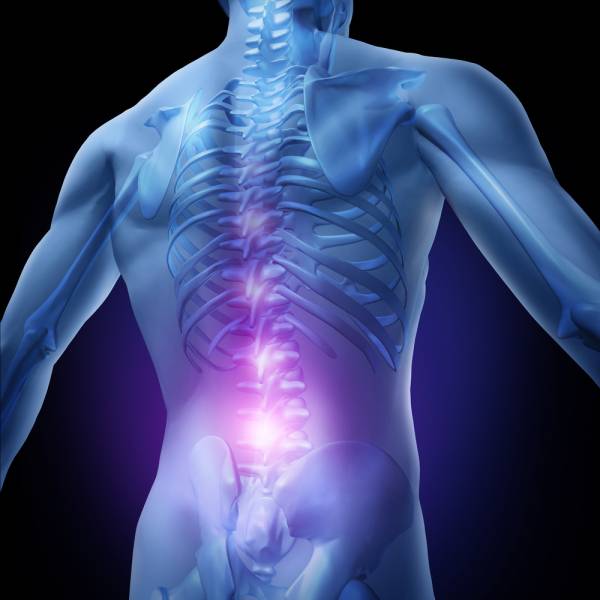<strong”>Everyone has his or her own expertise in life. For some people they are experts in sitting on the couch with a TV remote and the pizza restaurant on speed dial, others win Olympic Gold. Whatever it is that you do a lot of, you should become good at.
I have studied and treated human beings for a couple of decades. I’ve spent long days and nights in university libraries, late nights in the dissection rooms with cadavers for company, and have amassed a professional career of treating people in pain. I’m good at this and now I’m trying to educate a whole new breed of fitness professionals to become good at fitness rehabilitation. So, let me shine a light for you in the darkness of the back pain night.
Disc “Bulges” Are Not Forever
Disc bulges and injuries can go away without surgery. Even really big disc injuries like the one pictured. Below is a before and after MRI of a patient of mine, who had a huge injury. Look at the after photo and you can see what the spinal canal should look like, then the before and you can see this is a big one. It looks like someone sneezed on his MRI, there is that much junk in the spinal canal. Three months from that MRI to total freedom from disc injury is what he achieved.
After an Injury Training Should Be Expected to Return to Normal
I’ve had quite a few patients with disc injuries this big and thousands with lesser size injuries, and I’m close to a 100% success rate in getting them back to whatever they wanted to do. In the case of the guy in the before and after scans, he was back into the gym doing calf raises with 1,000lbs within six months. This was after he got back the control of his calf muscle due to the nerve injury concurrent to the disc injury.
No, I did not tell him to do those calf raises. It is just what he wanted to do, and I had no problem with his personal choice. I just showed him the tools to achieve his goals as the disc resolved. This is the greatest skill in low back injury treatment – getting the patient back to 100% of pre-injury function. It takes specific exercise application, including strength exercise both for hypertrophy and skill.
Once the Injury Is Healed, You Do Not Need Ongoing Treatment
Don’t let anyone tell you a disc injury is for life. I’ve got files full of MRI evidence of disc injuries being healed, and they don’t need monthly “adjustments” to keep them “in line” either. These people may naturally incur other injuries in the course of their pursuits, but once I solve a disc injury I expect it to stay that way, as long as the patient keeps doing the work I prescribe (forever), then they can go ahead and pursue the dreams and goals they had interrupted.
The specific exercises I prescribe will vary with each patient and are related to each personal history, presentation, lifestyle, and occupation. So I can’t give you a cookie-cutter treatment protocol for everyone today, but I just wish to show you that even big problems can be solved. It’s just a matter of finding the right answer and not giving up.
Here below is an example of the disc in the healing process. The balloon-like bulge is being healed and will return to normal. The process is a bit too complex to describe fully in this brief article, but when I teach courses on low back rehabilitation, I go through this process in detail.


Left: before; Right: after.
Pain Can Come From an Uninjured, Normal Scanned Disc
You do not need to have a disc bulge, rupture, or herniation to have pain from your disc. Sure, the injuries you see on an MRI like above, can be correlated to the symptoms, but experiencing pain that is from a disc and yet having the disc appear perfect on an MRI is certainly a more common clinical picture.1
You Can Have Pain Without Injury
Not as strange as it first sounds. Most often these pains relate to stretch receptors in the ligamentous tissues being stimulated. I have found these problems the easiest to solve, as it usually involves an examination of the person’s lifestyle and daily postures to provide a solution. Funny enough, these are often the people who come to me after seeing everyone else. The ones that doctors put up their x-rays and scans and can’t find the problem, yet all the while the patient is sitting there slumped on a stool.
You will find this in many areas of health and fitness, where a client bounces from trainer to trainer or doctor to doctor in despair of finding a solution. There are some classic questions and tests you can learn that will help you sort these people out swiftly, and the solution is usually a significant alteration in the patient’s ergonomic comfort zone, or stopping them from doing an exercise that someone else gave them that is perpetuating the problem, not solving it.
Healing a Person Can Be as Simple as Stopping the Wrong Exercise
An example of what I just mentioned is pulling your knees to your chest, in the case of posterior disc injury. This classic exercise prescribed in low back pain is from the famous Williams flexion exercises for back pain, these exercises are still prescribed today and are almost as universally wrongly applied as the day they were first published in 1965.2 The concept that spinal flexion exercise is a universal cure for low back pain even flies in the face of 2,400 years of evidence to the contrary that can be traced back to Hippocrates in 400 BC who recommended pressing sharply on the lumbar kyphosis of a patient with low back pain.3
Pain Is Not Expected to Be Proportional to the Injury
 Knowing low back pain can be present without tissue injury, then it can obviously exist when there is actual damage. But there is no rule that says the pain is proportional to the injury size. Pain is a construct of your mind; biological injury is damage to living tissue. (This is another article in itself.) Simply remember the pain is rarely proportional to the injury. Some of the people I have met in the greatest amount of pain, often in the hospital unable to move from the bed, had little if any demonstrable injury on their scans. And all the biggest disc injuries I have treated were in people who were able to walk through my front door (even if they were dragging their leg).
Knowing low back pain can be present without tissue injury, then it can obviously exist when there is actual damage. But there is no rule that says the pain is proportional to the injury size. Pain is a construct of your mind; biological injury is damage to living tissue. (This is another article in itself.) Simply remember the pain is rarely proportional to the injury. Some of the people I have met in the greatest amount of pain, often in the hospital unable to move from the bed, had little if any demonstrable injury on their scans. And all the biggest disc injuries I have treated were in people who were able to walk through my front door (even if they were dragging their leg).
Biological Healing Time Is Universal
The biology of healing an injury is universal to human tissue. (A good summary is Evans P. “The Healing Process at Cellular Level: A Review” Physiotherapy, August 1960 vol 66, no. 8.) In back pain, the statistics of injury resolution are approximately 86% of people are feeling better at four weeks post injury and 92% are better at eight weeks, regardless of the treatment.5 This is a good ballpark figure to go by, as I’ve read a heap of studies on back pain resolution and those numbers correlate to clinical practice observations.
The word better I think is worthy of discussion, because better does not necessarily mean resolved, does it? I aim for back pain resolution, not just better. Remember there is no such thing as a fast healer. There are normal healers or slow healers only (drug assistance not considered). So, you can be out of pain quickly, but remember pain is not injury. Pain is your conscious construction of various inputs, it does not directly relate to healing. It relates to removing the painful inputs to the brain, which may involve healing, but also may not.
I usually have people out of pain fast, but temper their enthusiasm by teaching them to respect the biological healing parameters. Once you remove or reduce the pain, then your client is going to be able to pursue the active components of the rehabilitation exercise to the optimum prescription.
Treat Each Personal as an Individual – They Are Not Recipes!
The key to full success in treating low back injury, once you have a handle on the cause of the problem, is to understand that each person is different, not different in basic biology, but psychology. This is why in the health and fitness profession, the successful trainers are those who understand each client’s different needs. In the treatment of injury, it’s the same. We have the universal principles of biology, biomechanics, and physics to apply, but we also need an element of understanding human behavior, because this influences the patient’s successful transition for injury to sporting return.
Injuries Can Be Totally Healed and Not Require Ongoing Treatment
Okay, so you now know even big disc injuries are not to be feared. They can be healed totally without lasting deficit. It then requires the perfect combination of passive, active, and neural rehabilitation strengthening exercises and progressions to take the patient back to optimum recovery and return to excellence of performance. (None of which, by the way, requires you to pull your damn belly button in!)
References:
1. Bogduk N. 1989, “Pathology of Lumbar Disc Pain” AAMM Vol 5 No.1.
2. Williams P.C. The Lumbosacral Spine, Emphasizing Conservative Management. New York, Blakiston Division, McGraw-Hill, 1965
3. Schiotz E, Cyriax J. Manipulation: Past and Present. London Heinemann and Son. 1975
4. Evans P. “The Healing Process at Cellular Level: A Review” Physiotherapy, August 1960 vol 66, no. 8
5. The McKenzie Institute Australia, Part A. The Lumbar Spine. Course notes
Photos 1&2 courtesy of Andrew Lock.
Photo 3 courtesy of Shutterstock.






